This set of Air Pollution Control Multiple Choice Questions & Answers (MCQs) focuses on “Atmospheric Stability and Inversion – Set 2”.
1. When does radiational inversion occur?
a) During night time
b) During the daytime
c) During cyclones
d) Over the oceans
View Answer
Explanation: Inversions are conditions of increasing temperature with altitude. In the case of radiative inversion, this type of inversion happens at night time, when the land cools. Valleys are primarily affected by radiational inversion.
2. Which areas are affected by radiational inversion more so than others?
a) Desert areas
b) Oceanic areas
c) Mountainous areas
d) Low-lying areas
View Answer
Explanation: Low-lying areas, as well as valleys, are affected by radiational inversion. Here the temperature increases with altitude at night time. The cooler air sinks below warm air by virtue of its density.
3. Which kind of inversion is more harmful than radiational inversion?
a) Radiational inversion is the most harmful
b) Subsidence inversion
c) Advective inversion
d) They are all equally harmful
View Answer
Explanation: Radiational inversion is potentially less harmful than subsidence inversion. It is true because the radiational inversion is temporary, it persists only in the night time and is absent in the day, unlike subsidence inversion, which can last for a few days.
4. When is the advective inversion formed?
a) Subtropical regions
b) At night time
c) When warm air moves over a cold surface
d) Cyclonic conditions
View Answer
Explanation: Advective inversion formation occurs when a gust of warm air passes over a cold surface or cool air. This kind of inversion is of two types: ground-based and elevated condition. Radiational inversion occurs during night time.
5. How many kinds of advective inversion are there?
a) 2, ground-level and elevated-level
b) 1, ground-level
c) 3, ground-level, elevated, and oceanic
d) 1, oceanic
View Answer
Explanation: There are two kinds of advective inversion. This kind of inversion occurs on the surface of the earth, or it may occur at elevated-levels. Advective inversion occurs when warm air passes over cool air or a cold surface.
6. Warm air moves over a hill, and a gust of cold air moves towards it in the opposite direction. Which kind of inversion is this example?
a) Ground-level advective inversion
b) Elevated advective inversion
c) Radiational inversion
d) Subsidence inversion
View Answer
Explanation: Warm air moves over hills at high levels, and cold air moves at low levels in the opposite direction; it is an example of elevated advective inversion. The ground-level advective inversion would occur when warm air flows over cold surfaces.
7. During inversion, air molecules and air pollutants undergo horizontal mixing.
a) True
b) False
View Answer
Explanation: Vertical mixing does not occur in the case of inversion because the atmosphere is stable. This is because the atmosphere is stable, thus, preventing vertical mixing. In such cases, horizontal mixing occurs in the direction of the wind.
8. What is the area indicated by the question mark?
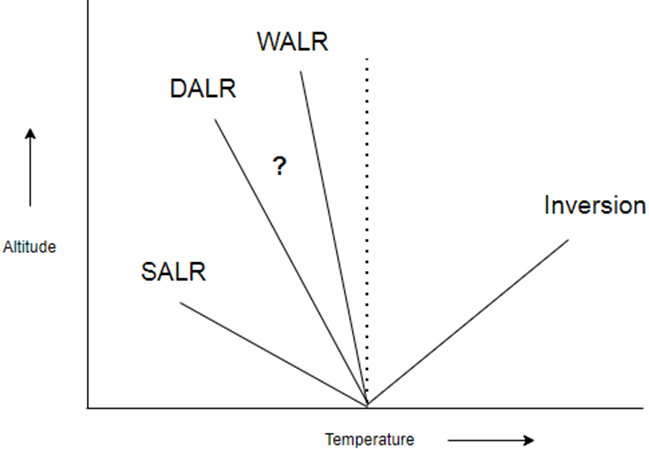
a) Lapse rate
b) Absolute instability
c) Absolute stability
d) Conditional stability
View Answer
Explanation: The area indicated by the question mark is the area of conditional stability. For such a condition to exist, the environmental lapse rate lies between wet and dry adiabatic lapse rate. The question mark lies between both of these lapse rates.
9. What is the condition indicated by the dotted line (question mark)?
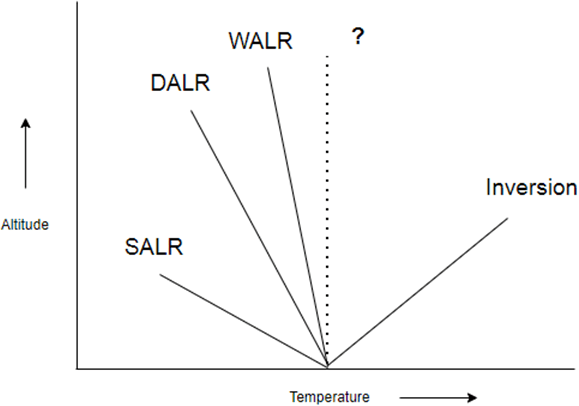
a) Isobaric conditions
b) Isochoric conditions
c) Isothermal condition
d) Subadiabatic lapse rate
View Answer
Explanation: The graph indicates the change in temperature with altitude. The dotted line is parallel to the y-axis, which means that the temperature remains constant with increase in altitude signifying isothermal conditions.
10. Which of the following options correctly names the line indicated by the question mark? (DALR – Dry Adiabatic Lapse Rate, WALR – Wet Adiabatic Lapse Rate)
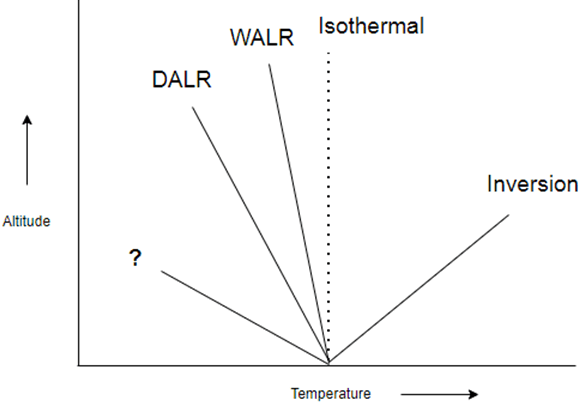
a) Subadiabatic lapse rate
b) Superadiabatic lapse rate
c) Environmental lapse rate
d) Moist adiabatic lapse rate
View Answer
Explanation: The question mark highlights a line, which is the superadiabatic lapse rate. This condition occurs when the environmental lapse rate is greater than the dry adiabatic lapse rate. It is indicated by the DALR line adjacent to the SALR line.
11. Which of the following options correctly names the line indicated by the question mark?
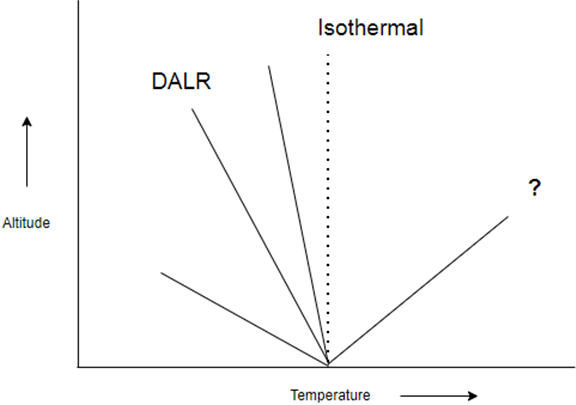
a) Subadiabatic lapse rate
b) Superadiabatic lapse rate
c) Inversion
d) Environmental lapse rate
View Answer
Explanation: For the line indicated in the graph, the temperature increases with altitude. For inversion, the temperature increases with distance from the surface. Therefore, the plot indicated by the question mark is that of inversion.
12. What is the area after the wet adiabatic lapse rate indicated by the question mark?
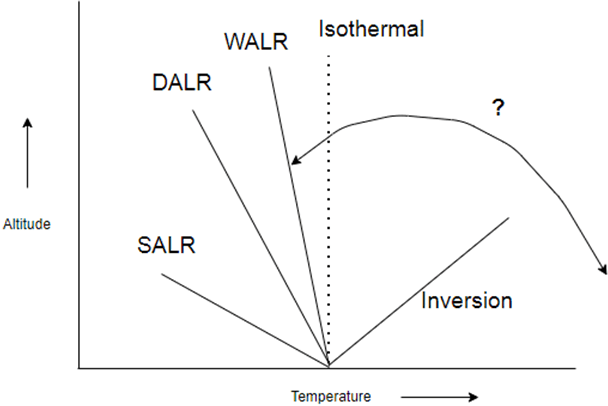
a) It is difficult to say
b) Instability
c) Stability
d) Absolute stability
View Answer
Explanation: The area indicated by the question mark is that of absolute instability. Here the air pollutants and air molecules mix vertically and disperse quickly. Here the wet adiabatic lapse rate is greater than the environmental lapse rate.
13. What is the area after the dry adiabatic lapse rate indicated by the question mark?
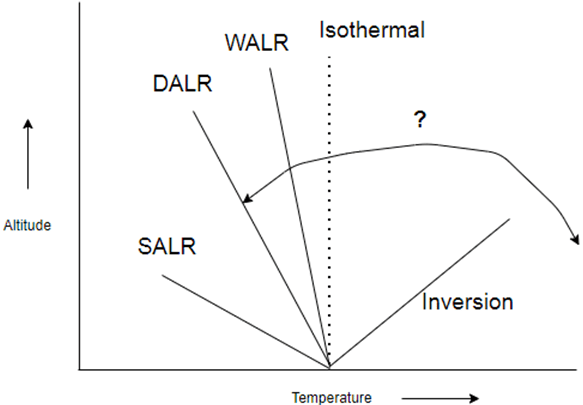
a) Stability
b) Instability
c) Absolute stability
d) It is difficult to say
View Answer
Explanation: The area indicated by the question mark is the area of stability. The area between wet and dry adiabatic lapse rate is of conditional stability, and area after wet adiabatic lapse rate is of absolute stability. Here, the atmosphere does not undergo vertical mixing.
14. What is the area before the dry adiabatic lapse rate indicated by the question mark?
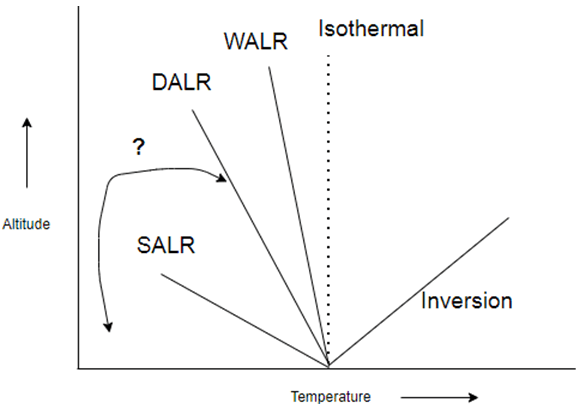
a) Stability
b) Instability
c) Absolute stability
d) Neutrally stable
View Answer
Explanation: The area indicated by the question mark is that of instability. It occurs when the environmental lapse rate is greater than the dry adiabatic lapse rate. For a neutrally stable atmosphere, ELR = DALR.
15. Which of the following correctly named the plot for subadiabatic lapse rate?
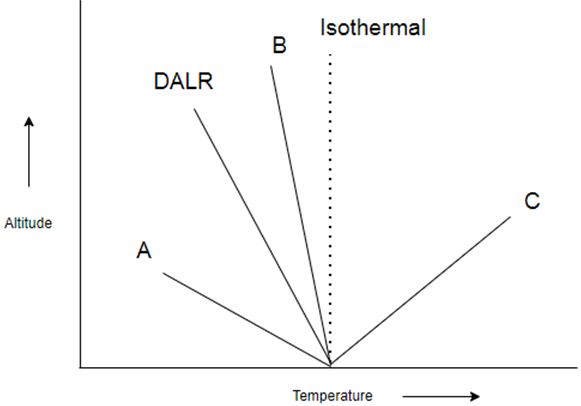
a) A
b) B
c) C
d) It is difficult to predict
View Answer
Explanation: None of the plots indicates the subadiabatic lapse rate. In such a case, ELR < DALR Plot A is superadiabatic lapse rate (ELR > DALR); plot B is the wet adiabatic lapse rate; plot C is inversion.
Sanfoundry Global Education & Learning Series – Air Pollution Control.
To practice all areas of Air Pollution Control, here is complete set of 1000+ Multiple Choice Questions and Answers.
If you find a mistake in question / option / answer, kindly take a screenshot and email to [email protected]
